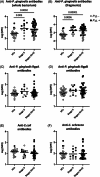Evaluation of circulating IgG antibodies against Porphyromonas gingivalis or its gingipains as serological markers of periodontitis and carriage of the bacterium
- PMID: 38884611
- PMCID: PMC11866731
- DOI: 10.1002/JPER.23-0766
Evaluation of circulating IgG antibodies against Porphyromonas gingivalis or its gingipains as serological markers of periodontitis and carriage of the bacterium
Abstract
Background: Increasing evidence indicates that periodontitis contributes to systemic low-grade inflammation. Porphyromonas gingivalis is strongly associated with periodontitis, and antibodies against the bacterium may be used as a serological proxy to account for periodontal status, when studying diseases associated with periodontitis. The aim of the present study is to identify an easily accessible and reliable serological biomarker for determination of periodontal status and oral carriage of the bacterium.
Methods: Saliva and serum samples were collected from periodontally healthy controls (n = 27), and patients with periodontitis stage II (n = 12) or stages III or IV (n = 44). Serum levels of immunoglobulin G (IgG) antibodies against intact and fragmented P. gingivalis, recombinant gingipains (RgpA and RgpB), and the bacteria Escherichia coli and Capnocytophaga ochracea as controls were quantified with a multiplex bead-based assay. P. gingivalis was identified in saliva using quantitative polymerase chain reaction (qPCR).
Results: Serum IgG antibodies against P. gingivalis whole bacteria were good indicators of periodontitis (area under the curve [AUC]: 0.75, 95% confidence interval [CI]: 0.64-0.85). The same was observed for levels of antibodies against P. gingivalis fragments (AUC: 0.78, 95% CI: 0.68-0.88). Likewise, levels of antibodies against P. gingivalis whole bacteria or P. gingivalis fragments were good indicators of oral carriage of P. gingivalis (AUC: 0.92, 95% CI: 0.86-0.98 and AUC: 0.96, 95% CI: 0.92-1, respectively). Conversely, antibodies against recombinant RgpA and RgpB were not good indicators of periodontitis or oral carriage of the bacterium. None of the antibody levels differed significantly between stage II and stage III or IV periodontitis.
Conclusion: Serum IgG antibody levels against heat-inactivated whole P. gingivalis proved to be the preferable biomarker for periodontitis and oral carriage of the bacterium.
Keywords: Porphyromonas gingivalis; biomarker; immunoglobulin; periodontitis.
© 2024 The Authors. Journal of Periodontology published by Wiley Periodicals LLC on behalf of American Academy of Periodontology.
Conflict of interest statement
All authors declare no financial conflicts of interest.
Figures

Similar articles
-
Gingipain-specific IgG in the sera of patients with periodontal disease is necessary for opsonophagocytosis of Porphyromonas gingivalis.J Periodontol. 2005 Oct;76(10):1629-36. doi: 10.1902/jop.2005.76.10.1629. J Periodontol. 2005. PMID: 16253083
-
Antibody responses of periodontitis patients to gingipains of Porphyromonas gingivalis.J Periodontol. 2003 Oct;74(10):1432-9. doi: 10.1902/jop.2003.74.10.1432. J Periodontol. 2003. PMID: 14653388
-
Serum immunoglobulin G (IgG) and IgG subclass responses to the RgpA-Kgp proteinase-adhesin complex of Porphyromonas gingivalis in adult periodontitis.Infect Immun. 2000 May;68(5):2704-12. doi: 10.1128/IAI.68.5.2704-2712.2000. Infect Immun. 2000. PMID: 10768963 Free PMC article.
-
The role of gingipains in the pathogenesis of periodontal disease.J Periodontol. 2003 Jan;74(1):111-8. doi: 10.1902/jop.2003.74.1.111. J Periodontol. 2003. PMID: 12593605 Review.
-
Porphyromonas gingivalis gingipains: the molecular teeth of a microbial vampire.Curr Protein Pept Sci. 2003 Dec;4(6):409-26. doi: 10.2174/1389203033487009. Curr Protein Pept Sci. 2003. PMID: 14683427 Review.
Cited by
-
Exploring heme and iron acquisition strategies of Porphyromonas gingivalis-current facts and hypotheses.FEMS Microbiol Rev. 2025 Jan 14;49:fuaf019. doi: 10.1093/femsre/fuaf019. FEMS Microbiol Rev. 2025. PMID: 40343779 Free PMC article. Review.
References
-
- Caton JG, Armitage G, Berglundh T, et al. A new classification scheme for periodontal and peri‐implant diseases and conditions‐Introduction and key changes from the 1999 classification. J Clin Periodontol. 2018;45(2):S1‐S8. Suppl. - PubMed
-
- Stødle IH, Verket A, Høvik H, Sen A, Koldsland OC. Prevalence of periodontitis based on the 2017 classification in a Norwegian population: the HUNT study. J Clin Periodontol. 2021;48(9):1189‐1199. - PubMed
MeSH terms
Substances
Grants and funding
LinkOut - more resources
Full Text Sources
Molecular Biology Databases

